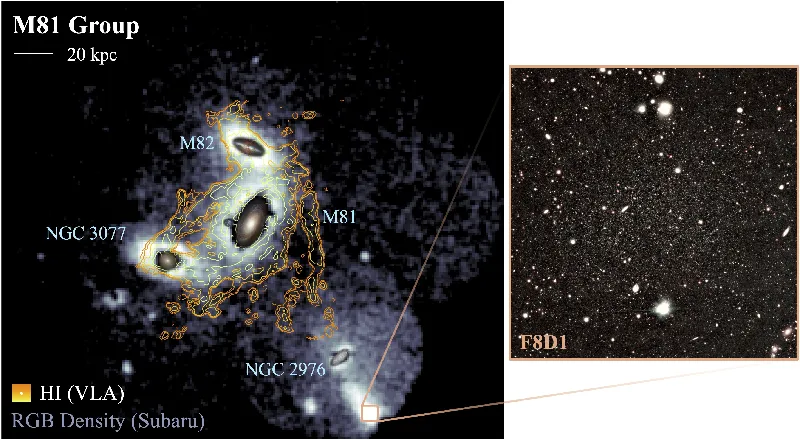Decoding the Enigma of F8D1: A Deep Dive into the Evolution of Ultra-Diffuse Galaxies

In the vast expanse of the universe, ultra-diffuse galaxies (UDGs) like F8D1 challenge conventional understandings of galaxy formation and evolution. Recent research, emphasizing deep imaging from the Hubble Space Telescope, has unveiled the intricate star formation history (SFH) of F8D1, a UDG satellite of the M81 Group. This enlightening study not only sheds light on F8D1’s cosmic past but also raises questions about the very nature of UDGs in general.
What are Ultra-Diffuse Galaxies?
Ultra-diffuse galaxies are an intriguing class of galaxies characterized by their low surface brightness and large size. These galaxies often exist in groups or clusters yet perplexingly, some appear nearly untouched by tidal forces, reminiscent of their more massive counterparts. The study of UDGs challenges astronomers to reconsider conventional galaxy formation theories. F8D1, classified as an ultra-diffuse galaxy, is especially notable due to its mystery-laden history of star formation.
A Glimpse into F8D1’s Star Formation History
Utilizing advanced imaging techniques, researchers found that F8D1 experienced notable bursts of star formation approximately 2 billion years ago and a smaller resurgence around 500 million years ago. These findings suggest that while F8D1 is currently quiescent, it was once a vibrant galaxy teeming with star formation, in stark contrast to its current low activity level. The total estimated stellar mass of F8D1 is around 1.3×108 solar masses, which can be compared to the size and make-up of similar galaxies.
The Role of Tidal Forces
A significant aspect of this research is the impact tidal forces have on F8D1. An extensive tidal stream was discovered extending from the galaxy, suggesting that interactions with its central galaxy M81 and possibly NGC 2976 have greatly influenced its evolution. The tides not only shape the physical structure of F8D1 but may also be responsible for its more recent star formation bursts, where gravitational interactions with neighboring galaxies have triggered bursts of star creation.
F8D1 and Its Implications for UDG Research
F8D1 represents a key case study for understanding ultra-diffuse galaxies. The observed star formation history underscores the complexities that accompany UDG formation theories, suggesting that a variety of processes—including environmental effects like tidal interactions—play crucial roles in shaping these extraordinary galaxies. While theoretical models of UDG formation exist, F8D1’s nuances challenge astronomers to consider a multi-faceted approach to understanding these cosmic entities.
Conclusions: A Cosmic Puzzle Yet to Be Solved
As researchers continue to unravel the layers of F8D1’s history, it becomes increasingly clear that UDGs like it embody the dialogues of cosmic evolution. Their study not only enhances our understanding of galaxy formation but also fills in the gaps regarding the evolution of galaxies across different environments. The mysteries surrounding F8D1 and its ilk ensure that the quest for knowledge in astronomy remains as vast as the universe itself.